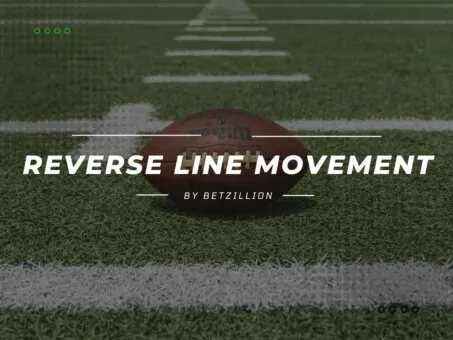This website uses cookies so that we can provide you with the best user experience possible. Cookie information is stored in your browser and performs functions such as recognising you when you return to our website and helping our team to understand which sections of the website you find most interesting and useful.
Moneyline Betting Explained

Moneyline is no more than a simple 1×2 bet. There’s no other way to define it – it gives you a chance to pick the winning team in a match. All you need to do is to wager on one option or the other. Betting the moneyline is very easy online since every bookie will have a line with odds you need to click on. The best sportsbooks will offer great returns on this bet and have it readily available for NBA, NHL, NFL, and MLB matches.
How to Make a Moneyline Bet
If you’ve ever placed a bet at an online bookmaker, moneyline shouldn’t be a concern. Bookies will offer moneyline odds on all (or nearly all) matches in their sports library. You can place sports betting money line relatively easily regardless of football, basketball, or tennis.
Please find what you want to bet on, look at the odds, and click on them. You can do this from your PC or smartphone with ease. The bet will be added to your slip immediately, and the system’s calculator will show you a possible return instantly.
Moneyline Odds
The odds for moneyline bets are expressed in American format in popular sportsbooks. And luckily, the American odds format is fairly simple to understand. Here, odds with a minus sign, like -200, means you must wager that amount ($200) to win a $100 profit. In this case, the total payout would be $300.
On the other hand, if the odds have a plus sign, like +200, that shows the profit you’ll win for every $100 wager. If you wager $100, you’ll win $200, making your total payout $300.
Likewise, it’s vital to know how to read moneyline odds. Generally, favorites in moneyline bets have a minus sign next to their odds, like -110, while underdogs have a plus sign, like +110.
In some cases, you may find moneyline odds displayed in decimal format. To determine your potential profit, multiply the odds by 100 to transform them into American format, which is much easier to read.
How to Calculate Moneyline Odds
To understand how money line bets work, you must learn more about calculating the odds. You should first know that there are 2 different moneyline bets – positive and negative. The positive represents the underdog, while the negative represents the favorite.
To calculate the profit from positive moneyline odds, you can use this formula:
- Potential returns = stake x (odds/100)
If you, for example, put a $10 wager on odds of +150, your profit will be $15 for a total payout of $25.
When it comes to negative moneyline bets, the formula goes like this:
- Potential returns = stake / (odds/100)
Put a $15 bet on odds of -150, and you’ll net a profit of $15 for a total return of $25.
What Do Minus (-) and Plus (+) Odds Mean?
Learning how to read moneyline odds is easy. They are represented by positive (+) and negative (-) signs in front of them. The former represents the underdog, while the negative represents the favorite.
Betting on positive moneyline odds shows you how much profit you can expect on a wager of $100. When it comes to negative moneyline odds, they show how much you need to bet to win $100.
Why Are There Fractions or Decimals on the Moneyline?
Full numbers always represent Moneyline odds. They don’t come with fractions or decimals unless you convert them to decimal format.
The best sportsbooks in the business have a tool that easily converts the odds to whatever format you feel most comfortable with. Odds of -150 converted to decimals will be roughly 1.66 and 2/3 when it comes to fractional odds.
If you bet on odds of +120, the fractional odds are 6/5, while the decimal equals 2.2.
How and Why Do Moneyline Odds Change?
Like other bet types, moneyline odds change frequently for several reasons. Some of the major ones include:
- Lineup changes: It’s common for players to get injured and get removed from a lineup. Likewise, some players may be removed from the lineup and switched for more rested players. Since such actions can impact the team’s performance, moneyline odds must reflect these changes.
- Weather forecast: Outdoor sports like baseball, football, and soccer depend on fair weather for optimum performance. So, if the weather forecast predicts extreme changes like rain or snow, it’ll affect the game’s performance and overall score, causing the bookmaker to adjust the moneyline odds.
- Betting action: If many bettors are betting on a specific team or result, the bookie will attempt to even out the betting field by changing the moneyline odds. After all, the bookie must still make a profit regardless of the outcome.
- Public perception: Likewise, the popularity of a particular team and its winning chances influence the movement of moneyline odds. Suppose a team has recently become a favorite among bettors due to its improved performance. In that case, the bookie will likely increase the moneyline odds to reflect the extra interest in the team from the public.
Notably, only a few books set moneyline odds. Most of them copy from market-setting bookmakers. You can easily find books that set odds with a little internet research.
Betting the Moneyline: Implied Probability
Implied probability in sports betting refers to the percentage likelihood of a bet to be successful based on the given odds. It also factors in the bookmaker’s juice, meaning the percentage provided might slightly veer off the true outcome.
Apart from benefitting moneyline bettors, implied probability also helps other punters to track event probabilities in various betting markets. In this case, players would discover the likelihood of their favorite team winning a match, allowing them to place more informed bets.
It is where good implied probability comes into play. It’s where there’s a higher percentage of the desired outcome happening. For example, if the moneyline odds are at least -200, the implied probability would be 66%, as given by an implied probability calculator. But you can also calculate implied probability manually. The formula is:
Positive odds: 100/ (x+100) x100
Negative odds: x/ (x+100) x100
(X is the value of the odds)
So, in this case, it would be 200/ (200+100) x100 = 66%. Anything above 50% is a good implied probability.
Line Shopping: How Bettors Should Approach Moneyline Bets
Before settling on a moneyline bet, you must determine your estimated implied probability of the game independently from bookmakers. For example, your statistics may have found that the Lakers have an 80% implied probability, meaning there’s great potential value. The next step is line shopping.
Here, you’ll have to browse through several bookmakers to find odds with the most possible value. For instance, you may find a bookie that offers Lakers moneyline odds of -350 at Fanduel and -380 at Draftkings. I know the difference doesn’t sound like much, but trust us, it’s plenty.
Let’s look at things more practically. So you have two different moneyline odds: -350 and -380. If you plan to wager $100, the difference in profit between the two is $30. Of course, that’s not much after a one-time win. But once you accumulate it long-term, you’ll see what $30 is worth.
Why Was My Moneyline Bet Cancelled?
There are several reasons why a moneyline bet can be voided or canceled. First, it could be because a game ended in a tie. Although it’s not common in many sports, there are those, like the NFL, where tied-end scores are possible. In this case, if the bookie only offered two-way markets, it will refund your moneyline bet.
Another reason a bookmaker would cancel a moneyline bet is if the game does not take place on the scheduled day or ends early. It could result from extreme weather changes or something even more important.
In baseball, if your moneyline bet gets canceled due to ‘pitchers listed,’ it means that the expected starter pitcher didn’t throw the initial pitch for the team. Such occurrences usually affect the entire lineup, impacting moneyline odds.
Luckily, bookies return the bet amount after canceling moneyline bets. You can still place another moneyline wager or any other bet type.
How to Handicap Moneyline Bets
Moneyline sports betting works with any wager you can imagine, including handicaps. Handicaps give the weaker team a match advantage when the difference in quality is too big to ignore.
Handicaps are similar to point spreads which moneyline bettors know pretty well. A point spread doesn’t count in the outcome of the match. As long as you cover the spread, you will win your bet. It’s similar to handicap moneyline bets focused on goals rather than the match’s outcome.
Moneylines vs Point Spreads
The difference between moneylines and point spreads is quite big. The moneyline is the same as 1×2 betting without the draw. These bets give you a chance to predict the winner of the match. It will either be the favorite or the underdog. That’s the money line bet explained most – match betting, where you choose a side to win.
Moneyline and point spread bets are among sports bettors’ top three bet types. Many punters prefer these lines because of their odds and the different betting opportunities they offer. For moneyline wagers, you select which team you think will win the game. It’s either Team 1 or Team 2. There’s no in-between.
Regarding spread bets, punters must determine which team is more likely to cover the spread, which is the margin set by the bookie. So, if you believe Team 1 won’t win but can still score three or less than three points by the end of the game, then a spread bet potentially gives you a chance to win from this prediction.
Another major difference between these two bet types is that spread bets have better payouts than moneyline alternatives. That’s because spreads usually have higher odds.
The only similarity between these two bet types is the plus and minus sign against the odds. Teams with a minus sign are the favorites, while those with a plus sign are the underdogs.
Moneyline Parlays
If you want to combine your moneyline wagers in one bet slip, moneyline parlays are precisely what you need. You’ll place a one-off amount for a larger potential payout. The more moneyline bets you include in your parlay, the more you could win. Most sportsbooks allow you to combine up to 16 legs on your moneyline parlay. Notably, your moneyline parlay can only win if all legs are correct. As you can see, the risk is high—the more the legs in your moneyline parlay, the higher the risk.
Moneyline Strategy: Betting Favorites vs Betting Underdogs
While moneyline bets are simple, you can’t expect to win by putting your money on whatever team you think will win. Favorites will be favorites, and underdogs will always be underdogs. However, surprises often happen with moneyline bets. Backing up the favorite might seem like a bulletproof strategy, but to be honest, you can expect to make a profit that way.
The reason is that favorite odds in moneyline betting are never attractive. You’ll have to wait for a bookie to offer to enhance the odds to make a solid profit. Backing the underdogs all the time is not a good idea too. They can only beat favorites every once in a while, and until that time comes, you’ll lose a lot of cash.
That’s where betting strategies come in. Like with roulette or blackjack, sports betting works best when you apply a strategy. There’s no magical approach that works wonders for moneyline betting. Instead, the only basic strategy we can recommend is doing homework, limiting your bankroll, and reading tips and predictions.
Starting is simple. Like with any other type of bet, you need to do your research with moneyline too. Just because a team is a major favorite doesn’t mean it will win. If it has a previous bad record against the underdog, things might go south fast. No matter how big of a favorite a team is, it would help if you always did your research.
The next thing is deciding how much you want to bet. Putting a lot of money on low favorite odds is a risky approach. If your favorite has a bad day, you stand to lose a lot. Betting big on the underdog is risky, too, although you stand to earn a lot. However, you should keep your bets small and try to profit elsewhere rather than putting all your money on the moneyline.
Reading expert tips and predictions is also a great strategy to increase your chances of winning the sports betting money line. Many sites offer them for free. Regardless of putting a parlay or a single moneyline bet, you should see what experts are saying first. It will give you a clear idea of what to expect and possibly change your mind about a match. With a positive outcome, of course.
How to Win a Moneyline Bet
Moneyline betting is a simple yet thrilling adventure. But it’s much more than selecting the outright winner of a match. So, how can you increase your chances of winning big? Here are some tips to consider:
- Find the best value for your prediction, especially since moneyline favorites usually don’t pay much.
- Consider moneyline betting as a long-term strategy. Even if you lose a couple of money lines, you can still recoup your losses and register profits after some time, provided you make the correct selections.
- Although many believe moneyline favorites are not worth the risk, don’t neglect them. As a general rule of thumb, favorites with odds ranging from -250 to -300 are not worth it. But you can include moneyline favorites in a parlay or give away some points in your bet to increase the potential payouts.
Example of a Moneyline Wager
Enter any betting site recommended by BetZillion, and you’ll find a zillion of moneyline bets. They are most likely the first thing you can see at a bookie before you get deeper into the other markets. To put things into perspective, let’s show a few examples.
A bookmaker will favor the Brooklyn Nets in the match against the New York Knicks. Let’s say the Nets are a -250 favorite, while the Knicks are the underdog at +300. As a favorite, these odds show how much you need to bet to net a $100 profit. If you place a $100 bet on the Knicks and they win, you will earn a profit of $300 for a total return of $400.
NBA moneylines are quite popular now, but these bets are also offered on soccer, American Football (NFL), ice hockey (NHL), and UFC fights. UFC moneyline bets are huge in Vegas, especially when the greats such as Nurmagomedov, Cormier, Miocic, or McGregor enter the octagon against a challenger.
What Sports Can Moneyline Betting Be Used For?
Example of the Moneyline for the NFL
To better understand how moneyline bets work, let’s look at this NFL example between the Green Bay Packers and the Chicago Bears.
| Green Bay Packers | Chicago Bears |
|---|---|
|
-210 |
+180 |
Here, the Green Bay Packers are the moneyline favorites with odds of -210. That means you’ll have to bet $210 to win $100 in profit, giving you a potential payout of $310. On the other hand, the Chicago Bears are the underdogs, with odds of -180. It means that if players wager $100, they’ll receive $180 in profits if the Bears win, resulting in a total payout of $280.
Example of the Moneyline for the PGA
Let’s say a bookmaker favors Jordan Spieth in the PGA tour and provides odds as follows:
| Jordan Spieth | -800 |
| Scottie Scheffler | +500 |
| Collin Morikawa | +650 |
If you wager $800 on Jordan Spieth, and he wins the PGA tour, you’ll get an extra $100, making your total payout $900. But if Collin Morikawa wins and you bet $100, you’ll receive a profit of $650 and a total payout of $750.
Unlike other sports, PGA events usually have fields of over 160+, giving golf bettors plenty of betting opportunities. And another thing about PGA and money lines is that the odds can go as high as 50,000. Generally, favorites are priced around the 800 mark, while underdogs can go as far as 20,000.
Example of the Moneyline for the NBA
NBA moneyline bets couldn’t be any simpler. As you would expect, you need to pick the team you think will win. Let’s look at the example below:
| Golden State Warriors | Memphis Grizzlies |
|---|---|
|
-250 |
+400 |
Here, the Warriors are favored to win this NBA match. So, if you wager on the favorite team, you’ll have to bet $250 to receive $100 in profit, giving you a total payout of $350. But if you choose to side with the Grizzlies, you’ll have to wager $100 to receive $400 and a total payout of $500.
Example of the Moneyline for MLB
Moneyline betting in the MLB is like any other. It involves betting on the game’s outright winner. Here’s an example:
| Texas Rangers | Houston Astros |
|---|---|
|
-130 |
+110 |
In this case, the Rangers are the designated favorites with odds of -130.
The Astros are the underdogs with odds of +110. So, if you think the Astros will win, you must wager $100 to get a profit of $110 and a total payout of $210. But that’s only if the Astros win the match.
Alternatively, if the Rangers win the game, you must have wagered $130 to receive $100 in profits and a total payout of $230.
Example of the Moneyline in the NHL
Want to learn how NHL moneyline bets work? Here’s a practical example:
| TampaBay Lightning | New York Rangers |
|---|---|
|
+270 |
-220 |
The New York Rangers are the moneyline favorites, with odds of 220, while the Tampa Bay Lightning are the underdogs, whose odds are 270. So, if we wished to wager on the Rangers, we must bet $220 to win $100 if the Rangers beat the NHL match. But if we want to wager on the Tampa Bay Lightning, a wager of $100 would provide profits of $270 if the team wins.
Example of the Moneyline in College Football
A college football moneyline wager means picking the outright winner of the match. Their scores don’t matter, provided there’s a winner. Let’s look at an example:
| Georgia | Clemson |
|---|---|
|
-160 |
+135 |
So if you wager $100 on Clemson and they win, you’ll receive $135 in profits and a total payout of $235. But if you wager on Georgia, you must bet $160 to win $100 in profits for a total payout of $260.
Example of the Moneyline in College Basketball
If you’re new to sports betting and love watching college basketball, moneylines is the right place to start. Although you may not win much, it’s an excellent way to dip your feet in the sports betting market without risking too much. Below is an example:
| Mississippi State Bulldogs | Pitt Panthers |
|---|---|
|
+105 |
-125 |
Let’s say the game ends with a score of 75-74, with the Bulldogs winning. According to the odds above, the Panthers were the favorites, and the Bulldogs were the underdogs. So, if you’re wager was on the Panthers, and you wagered $125, you lose the $100 in profits and the entire bet. But if you predicted the Bulldogs would win and bet $100 on them, you’ll receive $105 in profits and a total payout of $205.
Moneylines and Live Betting
Live bets are extremely popular among punters who enjoy fast-paced action. Luckily, most bookies include a moneyline live bet in the middle or quarter of a game to ensure that moneyline bettors don’t miss out on the action during their favorite games.
Such bets are usually excellent opportunities to cash in big wins because sportsbooks don’t have time to create sharp lines. But that also means they may include more VIG than in standard bets. So don’t get too excited. Analyze the odds well before placing that live moneyline wager. After all, you want to place a bet with the most value.
Moneyline Betting, Is It Worth It?
Is a moneyline worth it? We can say that it is if you use a good strategy. Moneyline betting is excellent for beginners since it’s elementary to understand. It’s the starting point for all punters before they go deeper into the labyrinth of online sports betting.
We hope that our guide showed you what moneyline means in betting. Using the tips above and examples, you should be able to place your first moneyline bet and hopefully collect the winnings.
Frequently Asked Questions
-
How does the moneyline work?Moneyline betting is a simple bet which allows you to predict who wins the match. It’s not complicated to understand and is very similar to 1×2 betting. However, you don’t get a draw to bet on this time, so you choose the underdog or favorite.
-
What does a +200 moneyline mean?A +200 moneyline means that if the underdog wins, you will get a $200 profit on a bet of $100. The total payout, in this case, would be $300.
-
How do you read the moneyline odds?Reading moneyline odds is simple – the minus sign represents the favorite, while the team or player with the plus sign is the underdog.
-
What pays more moneyline or spread?In general, a point spread can pay more money. However, moneyline can pay nice sums of cash if you get lucky with an underdog win.
-
How do you read a moneyline bet?To read a moneyline bet, you must learn more about the + and – signs in front of the team or player. The former represents the underdog, while the latter is for the favorite.
-
How Do Sportsbooks Make Money on Moneyline Bets?Like any other sports bet, bookies include vig or juice in their moneyline odds. Vig or vigorish is the percentage of the betting amount punters submit for a particular moneyline bet. That means the sportsbook will earn a percentage of the bet amount from the player regardless of the outcome.
-
Still have questions?
Ask our experts
Related articles
Granular Betting (1st Drive Result)
Reverse Line Movement





